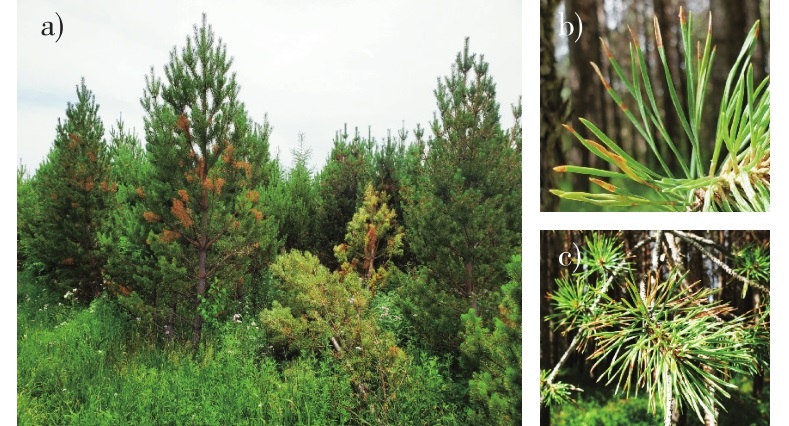 PDF(34809 KB)
PDF(34809 KB)


樟子松新型叶枯病的病原菌鉴定及防治药剂筛选
吴盈盈, 田呈明, 彭骋, 李双, 赵占永
南京林业大学学报(自然科学版) ›› 2025, Vol. 49 ›› Issue (4) : 170-178.
 PDF(34809 KB)
PDF(34809 KB)
 PDF(34809 KB)
PDF(34809 KB)
樟子松新型叶枯病的病原菌鉴定及防治药剂筛选
Identification and screening of fungicides of pathogen causing a new leaf blight disease in Pinus sylvestris var. mongholica
【目的】樟子松(Pinus sylvestris var. mongholica)适应性强,在我国“三北”地区广泛栽培。近年来,河北、内蒙古等地的樟子松上发生了1种未报道过的叶枯病,通过对该叶枯病的病原及其生物学特性开展研究,并进行防治药剂的筛选,为准确防控樟子松新型叶枯病提供依据。【方法】采用单孢分离法和组织分离法从樟子松罹病针叶上的子实体及病健交界处分离菌株,通过形态学观察及系统发育学分析对菌株进行鉴定,结合科赫氏法则验证不同菌株的致病性以确定病原菌种类。同时测定不同碳源培养基、pH、光照时间以及温度条件对该病原菌生长的影响。采用菌丝生长速率法研究10种杀菌剂对病原菌菌丝生长的抑制作用,并通过毒力方程计算出半数效应浓度(半致死浓度,EC50)。【结果】从不同症状表现的罹病针叶上共分离到84株真菌,其中菌株Z-17、Z-21、Z-22、Z-24对樟子松针叶具有致病性,并出现与林间相同的症状。上述菌株培养物形成的分生孢子座亚球形,分生孢子透明、无隔、光滑、近圆柱状至卵圆状,大小为(4.2~10.3)μm ×(2.5~6.3)μm,与针叶病斑上观察到的子实体形态一致,且分子系统学分析显示,其与多孢瑟氏腔菌(Sydowia polyspora)形成一个100%支持率的分支。结合形态学与分子系统学分析,将樟子松叶枯病的病原菌鉴定为多孢瑟氏腔菌(Sydowia polyspora)。该病原菌在以葡萄糖为碳源的培养基上生长速率最快,对淀粉的利用率最低;菌丝体在pH为3~9范围内均可生长,最适生长pH为5;连续24 h的光照条件对菌丝体的生长最有利;当温度达55 ℃时可致菌丝死亡。毒力测定结果表明,25%(体积分数,下同)腈菌唑、45%(体积分数,下同)咪鲜胺以及10%(质量分数,下同)苯醚甲环唑的EC50值分别为0.003 9、0.044 3和0.047 5 mg/L,对多孢瑟氏腔菌菌丝的生长均具有较明显的抑制作用,80%(质量分数,下同)代森锌的EC50值为16.693 g/L,抑菌效果最差。【结论】本研究鉴定樟子松上的1种新型叶枯病的病原菌为多孢瑟氏腔菌,菌丝生长最佳碳源为葡萄糖,最适pH为5,最适光照条件为连续24 h,菌丝致死温度为55 ℃,25%腈菌唑、45%咪鲜胺以及10%苯醚甲环唑对多孢瑟氏腔菌的抑制效果较好,为后续制定樟子松叶枯病的防控策略及其病原菌的致病机制提供了依据。
【Objective】Pinus sylvestris var. mongholica, a species with notable environmental adaptability, has been extensively cultivated in the Three-North regions of China. In recent years, a novel disease causing needle blight has emerged in P. sylvestris var. mongholica plantations in Hebei and Inner Mongolia. This study aimed to identify the causal pathogen, biological characteristics, and evaluate fungicide efficacy to establish scientifically grounded control measures for this disease.【Method】Isolates were obtained from both conidia and diseased tissues. Morphology combined with phylogeny identified the strains and the pathogen was determined by Koch postulates. The effects of different carbon source media, pH, photo period, and temperature conditions on mycelial growth were systematically investigated. Mycelial growth rate method was used to study the inhibitory effect of 10 fungicides on pathogen and calculated the value of EC50 through virulence regression analysis.【Result】A total of 84 fungal strains were isolated from symptomatic needles, among which isolates Z-17, Z-21, Z-22 and Z-24 exhibited pathogenicity toward P. sylvestris var. mongholica, reproducing disease symptoms consistent with field observations. Conidia of these strains were subspherical, hyaline, septate, smooth, nearly cylindrical to oval, measuring (4.2-10.3) μm × (2.5-6.3) μm, aligning with the morphological features of fruiting bodies observed on necrotic needles. Phylogenetic analysis demonstrated that the four strains clustered with Sydowia polyspora with 100% bootstrap support. Based on these findings, S. polyspora was identified as the causal agent of needle blight in P. sylvestris var. mongholica. Biological characterization revealed that glucose provided the optimal carbon source for mycelial growth, whereas starch was the least utilized. Mycelial growth occurred within a pH range of 3-9, with optimal growth at pH 5. Continuous 24 h light exposure most favorably supported mycelial development, and the lethal temperature for mycelia was 55 ℃. Fungicide screening indicated that 25%(v/v) myclobutanil (EC50 = 0.003 9 mg/L), 45%(v/v) prochloraz (EC50 = 0.044 3 mg/L), and 10%(m/m) difenoconazole (EC50 = 0.047 5 mg/L) exhibited the strongest inhibitory effects against S. polyspora. In contrast, 80%(m/m) thiram showed the poorest efficacy, with an EC50 value of 16 693 mg/L.【Conclusion】This study identified the pathogen of P. sylvestris var. mongholica leaf blight as S. polyspora, the optimal carbon source for mycelial growth was glucose, pH 5, light conditions were 24 h continuous, and mycelial lethal temperature was 55 ℃. Among the tested fungicides, 25% myclobutanil, 45% prochloraz, and 10% difenoconazole demonstrated superior inhibitory effects. This study provides a theoretical foundation for developing targeted management strategies and further elucidating the pathogenic mechanisms of S. polyspora.

樟子松 / 多孢瑟氏腔菌 / 致病性 / 生物学特性 / 毒力
Pinus sylvestris var. mongholica / Sydowia polyspora / pathogenicity / biological characteristics / toxicity
| [1] |
徐静, 孙洪志, 郭滨德. 帽儿山地区樟子松优良种源的选择[J]. 南京林业大学学报(自然科学版), 2017, 41(1):61-68.
|
| [2] |
赵金满, 韩馨悦, 程瑞明, 等. 塞罕坝自然保护区华北落叶松和樟子松人工林健康评价[J]. 南京林业大学学报(自然科学版), 2024, 48(3):199-206.
|
| [3] |
宋来萍, 刘礴霏, 王玉华, 等. 呼伦贝尔沙地不同树龄樟子松对气候的响应[J]. 南京林业大学学报(自然科学版), 2020, 44(2):159-164.
|
| [4] |
孙美玲, 黄麟, 叶建仁, 等. 我国用材林主要真菌病害致病机制及内生菌对病害的生防作用[J]. 南京林业大学学报(自然科学版), 2022, 46(6):225-232.
|
| [5] |
田呈明, 王笑连, 余璐, 等. 林木与病原菌分子互作机制研究进展[J]. 南京林业大学学报(自然科学版), 2021, 45(1):1-12.
|
| [6] |
李琳, 李鹏, 李娜, 等. 东阿拉善地区油松和樟子松病害种类及症状识别[J]. 中国森林病虫, 2021, 40(3):31-35.
|
| [7] |
王铮, 邵鹏, 钟斯文, 等. 樟子松不同病斑等级针叶内生真菌多样性及群落结构[J/OL]. 吉林农业大学学报,2022:1-9.
|
| [8] |
何秉章. 松针红斑病综述[J]. 森林病虫通讯, 1984, 3(3):27-29.
|
| [9] |
何秉章, 邓兴林, 刘成玉, 等. 松针红斑病的发病规律和防治[J]. 东北林业大学学报, 1990(5):15-22.
|
| [10] |
|
| [11] |
|
| [12] |
|
| [13] |
|
| [14] |
|
| [15] |
|
| [16] |
徐阳, 任洪婷, 王朴, 等. 樟子松赤枯病病原菌研究[J]. 西部林业科学, 2017, 46(1):91-95.
|
| [17] |
周丹丹, 刘强, 梁辉, 等. 低温等离子和1-甲基环丙烯调控糖酸代谢增强杏果对黑斑病的抗性研究[J]. 林业工程学报, 2023, 8(6):100-107.
|
| [18] |
王凡, 卞晓春, 刘陈玮, 等. 南通市蚕豆赤斑病病原菌鉴定及其抑菌药剂筛选[J]. 江苏农业学报, 2024, 40(10):1810-1817.
|
| [19] |
韩凤, 黄靖, 章文伟, 等. 多花黄精白绢病病原菌鉴定及室内药剂筛选[J]. 江苏农业学报, 2024, 40(12):2244-2253.
|
| [20] |
|
| [21] |
|
| [22] |
|
| [23] |
|
| [24] |
|
| [25] |
|
| [26] |
|
| [27] |
|
| [28] |
王佳, 钱莹莹, 王鹏, 等. 松生茎点霉的分离、鉴定及药剂室内毒力测定[J]. 东北林业大学学报, 2023, 51(9):126-132.
|
| [29] |
何秉章, 邓兴林, 杨殿清, 等. 樟子松落针病的病原菌和防治的研究[J]. 东北林学院学报, 1985, 13(2):75-81.
|
| [30] |
|
| [31] |
杨意, 刘波, 叶建仁, 等. 水杉赤枯病综合营林生态控制技术研究[J]. 南京林业大学学报(自然科学版), 2021, 45(6):90-98.
|
| [32] |
王浩宇, 刘建功, 袁泓昌, 等. 3种浸提液对樟子松种子萌发和幼苗生长的影响[J]. 森林工程, 2023, 39 (3): 30-39.
|
| [33] |
王佳, 周德宝, 张军生, 等. 基于高通量测序的樟子松叶部病害分析及叶际真菌群落多样性研究[J]. 中国农学通报, 2024, 40(5):27-33.
|
| [34] |
|
/
| 〈 |
|
〉 |